Although different sources assign dates to it varying within a 2-year range, the National Women’s Day emerging as a result of a riot in New York in 1908-1910 begins to be referred to in 1910 as March the 8th World Women’s Day, following the proposal of Clara Zetkin, a women’s rights activist from Denmark. In 1917, as the Soviet Russia gives women the right to vote, March the 8th becomes a national holiday, and finally, with the United Nations’ recognition of it as World Women’s Day in 1975, this important day ceases to be a celebration time for socialist and communist countries only and becomes a worldwide event, symbolizing the strikes, marches and struggles for electoral rights women have been organizing throughout history to defend their rights.
March the 8th thus enters the global agenda as a day dedicated to the advocacy of women’s workers’ and electoral rights and is a reminder throughout March for women’s universal human rights, and it emerges as a period during which men and women come together under women’s leadership to reveal the economic and social status of women in various countries.
Cover Image: International Women’s Day marchers in 1977. (Credit: Fairfax Media/Fairfax Media via Getty Images)
As Art50.net, we dedicate this month to an interview series with 4 of our female artists whose works explore womanhood and freedom of women. Every week until the end of March a new interview with another artist of ours will be added to this page. We wish you enjoy reading them.
March 22, 2018
Ece Gauer: If It’s the Truth One Is Looking for, One Should Draw Inspiration from Those Who Know It

In some belief systems there are young souls and there are old (wise) souls. Young souls try to discover the world; they run here and there, they are impatient, they try and fail, they sometimes hit the wall. The answers to the questions you ask them come swiftly; they seldom think too much. In time, life teaches them to take longer time to think.
I don’t know Ece Gauer in person; I only have this interview, and her young age as a fact. Her works, her answers make me think that Ece Gauer is one of those old-and-wise souls that came back into the world. Gauer has navigated through many areas ranging from photography to fashion design, from cinema to her contemporary figurative works; she received education in various countries, drew inspiration from various cultures and shared her habitat with them. Yes, she tried a great many things, she changed her mind a great many times but she gave me the impression that she did all these with that depth in her. Her combining life and art, her painting with her “heart”, her reflecting her inner world to us through a combination of elements from various cultures…
Read our interview with this young artist and decide for yourself, and don’t forget to follow her successful projects both in Turkey and abroad!
I.Ö.: You were born in Turkey and you continue your artistic career in Germany. As we have already mentioned, your art carries the traces of both. I’m asking this in order to understand a bit better the sensation you provoke in your art; shall we interpret it as the reflection of an artistic purgatory, or a resident of the world’s fusion of cultures?
E.G.: There have been times I myself thought of it as a purgatory but I can’t say so in my current point of view. I believe everything is part of a whole and related. Thus I’m all of them, neither in between them nor at somewhere precise. I’m simply on the road, focused on my discoveries and progress. And this is not specific to certain geographic regions, sometimes the floor tiles at a cafe in Italy draw my attention, or the patterns at a monastery in Nepal… symbols… If you ask me what triggers this, I would tell you what I read, experience and see.
Of course, I tried to develop an authentic style with eastern symbols, motifs and literary elements that doesn’t ignore the indispensable rules of painting originating from the Western school of thought.
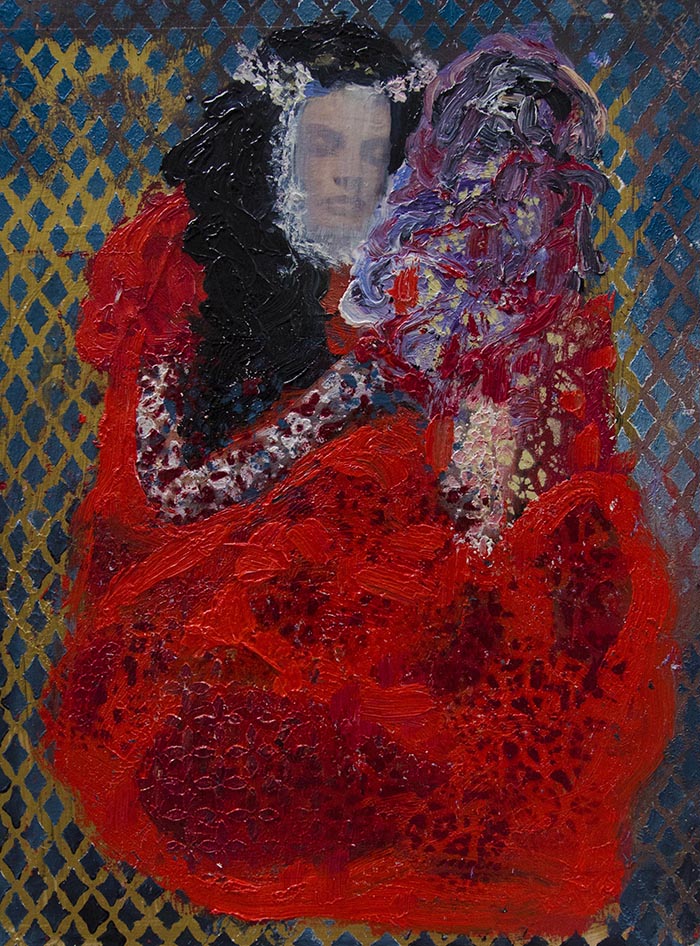
I.Ö: In your paintings, we see the reflection of an influence of the orient into the figurative art of the occident. All your figures are of women, if I’m correct. Is there a particular reason why you place women at the center of this cultural intersection?
E.G.: We can call it honesty. I’m trying to do what I know doing best. Searching oneself, discovering in my own journey and reminding myself of it while sharing it with others. To me, painting is an instrument of this journey, a word within a sentence. The woman has had an undeniable aesthetic place in art history, in fact, it was always considered an object by the art market that is usually dominated by a male hegemony, and was depicted as an aesthetic value. In our country, this situation is a bit different; in 1883, the School of Fine Arts did not accept female students. Male students were not too eager to apply either because in the Ottoman Empire, art was not fully embraced yet. In 1914, Inas School of Fine Arts was opened for women struggling for equal rights with men in art and under the leadership of Mihri Hanım, and this had a crucial role in the emergence of very valuable female artists dedicated to art in the history of Turkish art education.
Everything is atually a whole; different cultures, distances and languages are sometimes intermingled within one single environment and reappear before us within an entirely new discourse. Art is the most universal language that allows this to take place.
If we assume we live in a perceptual universe based on three dimensions and duality, what I do can be defined as taking all this as raw material, recombining them in the two-dimensional plane and reflecting them back on the surface. These are also manifest in color contrasts, big-small patterns, front vs. back and visible vs. invisible relationships. All motifs carry traces from every culture. Both symbols and motifs are crucial, they are a kind of language.
If I finally go back to the place of women in art, woman is the creator, the fertile, the productive one… She is sensitive and delicate, gracious and love-oriented. The artists embodies all these things. Therefore, if a female artist can truly reflect herself that energy is unleashed and the duality disappears, art and woman become one.
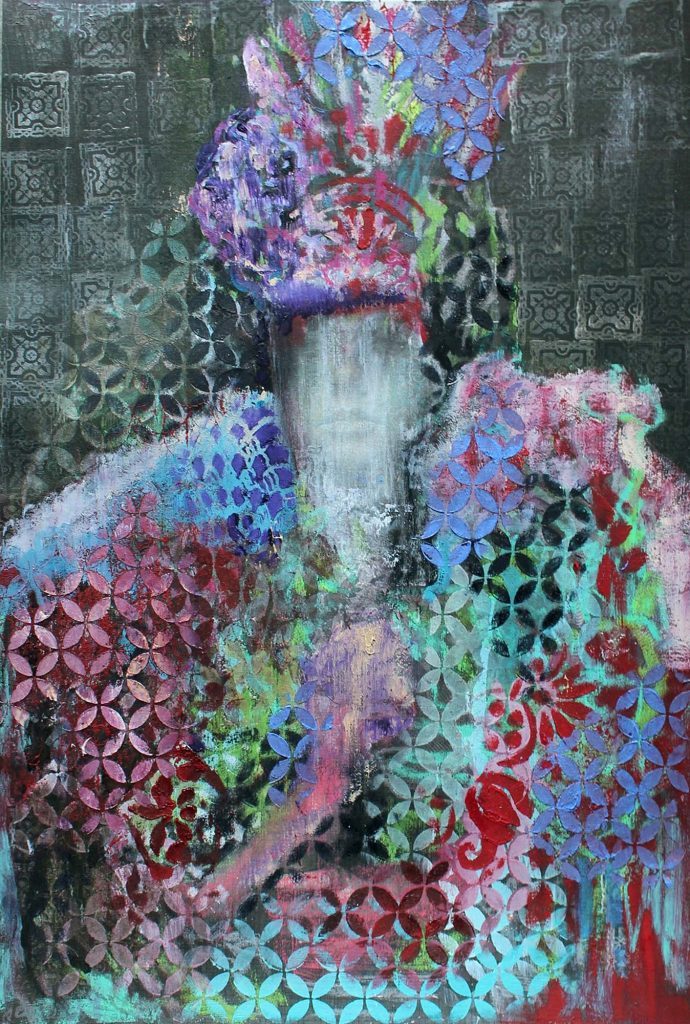
I.Ö.: In naming your woks at Art50.net you were inspired by Rumi. Can you tell us about the influence of Sufism and spiritualism on your art?
E.G.: I can say this influence is all pervasive, both in terms of my life and my art. I can’t distinguish them from each other. Everything develops automatically, like breathing, knowing very well what you do but not standing on its way. When you paint with your heart, with all that sincerity, then the painting begins to guide you through. It’s like a journey, it doesn’t matter where you are going, what matters is enjoying the ride and proceeding. While the painting proceeds like this, its nutritional sources have to be as sincere and real. If it’s the truth one is looking for, one should draw inspiration from those who know it.
I.Ö.: Your works have been exhibited in Germany, Turkey and France so far. We have seen on social media that you have recently been doing projects in Greece. What are your upcoming projects, where shall we expect to see you next?
Yes. There have been numerous exhibitions in Latvia, France and Germany. Of course, I would like to be everywhere in the world… I visit Greece so often because the studios of Anna Tourla, a colleague with whom we did several exhibitions together, and her father Thimios Tourla, a successful church painter, are based there. He provides me with a lot of information on iconography and symbols, and I have the opportunity to directly assist his work. Who knows, an exhibition in Greece could happen in the near future…
You may browse Ece Gauer’s works on Art50.net’s gallery here.
March 15, 2018
On Identities with Merve Dündar

In late 18th century, Jeremy Bentham, a British philosopher, designs a prison building he refers to as the “panopticon”. Here the inmates can be observed by one person all at once (pan) from the tower placed in the middle of this circular building (opticon); thus the tower can see all the cells but those in the cells cannot see the one in the tower. Although it’s not feasible for one man to monitor all the cells simultaneously, this design causes the inmates to change their behavior with the impression that they can be monitored all the time. According to some, the term panopticon is inspired by Panoptes, a multi-eyed giant in Greek mythology… In 1975, French philosopher Michel Foucault claims that the idea of the panopticon is the origin of power and discipline in modern society. Put very simply, although in a modern society we’re not physically confined or chained somewhere, we comply with various rules and norms with the belief of being constantly watched by an invisible authority.
In 1990s the Internet enters our lives, and first through simple operations, and then through ever increasing range of functions, it gradually begins to demand more and more information from us. Simple texting, social media where we share our work and leisure activities, writing word documents, internet banking we provide all our personal and private information with, listening to music, online television systems that record all our preferences, and much more is added to this list as we speak… Honestly, none of us really knows where we have ended up in this endless pit called the internet since the 90s. We now live in the “digital panopticon”, described by author Byung-Chul Han in his book and which inspires Merve Dündar the artist. Someone or even more people are watching us from a tower but we don’t know how often or when they do so, and we build ourselves some social lives and identities with this feeling of surveillance.
According to Merve Dündar, we are volunteers for being watched. She reflects on this feeling of surveillance, the boundaries between the individual and the social self, existence through the eyes of the other, and the desire for visibility. And while doing so, she refers to literature and creates collages with poems divided into words, as the latter bring a sort of enlightenment to the feeling of imprisonment in the artist’s inner world…
As part of our March Interview Series for Women’s Day, we talked to Merve Dündar about her series I and the Me, Biri Bizi Gözetliyor, my personal favorite, Nazar, her new exhibition and the idea of the woman’s self in her works.
I.Ö.: Art enthusiasts in Istanbul will have the chance to see your works at an exhibition that opened earlier this month. Congratulations, first of all. The new exhibition features your word collages. And you have previously used words in your Nazar series. You say that your art in general questions the idea of the self… Do the words give you some sort of self-expressive power that’s not available through material means? Can you tell us how you went back to using words in your art after the Nazar series?
M.D.: I use words as a medium to emphasize my visual forms and expressions. The work “Abyss” that was shown in the exhibition “Teşbihte Hata Olmaz” was like a continuation of the “Kelimeler” series shown at Tüyap. Kelimeler” consisted of those words I heard, read, assigned too much meaning to or none at all, and that moved me, that remained with me. They were works that I did during a troublesome, hopeless period of my life. I embarked on a venture in labelling my emotions, somehow to objectify my feelings and to liberate myself from this psychological state and this resulted in the works in the “Abyss” series that I can describe as the landscapes of my inner world. Nazar series, on the other hand, originate from Elif Şafak’s book “Mahrem” that I ready while I was working on the “Biri bizi gözetliyor” and “I and the Me” series. “İlmek”, the work currently on view has its departure point in İpek Duben’s “Manuscript” (1994) and Pablo Neruda’s “We Are Many”. It’s a collage composed of these poems’ verses.
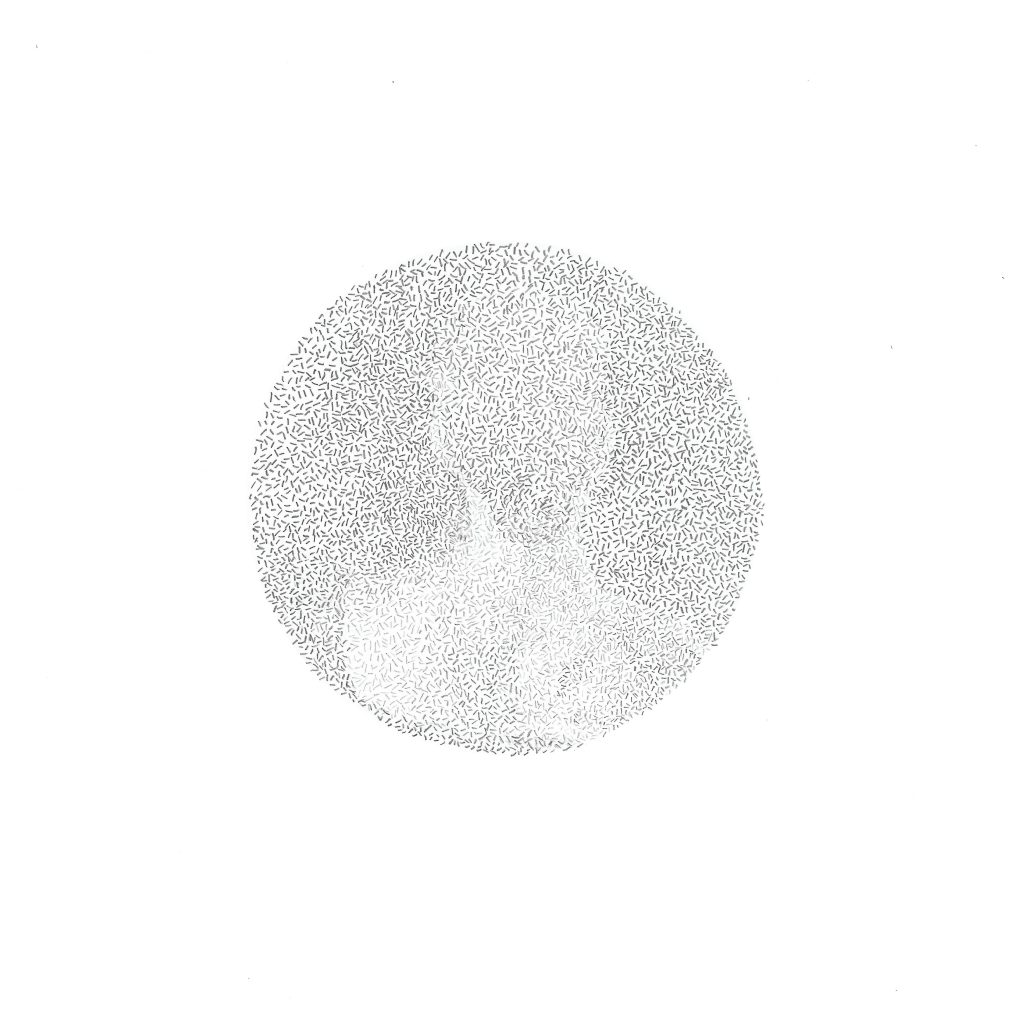
I.Ö.: In my view, I and the Me and Biri Bizi Gözetliyor series featured on art50.net have a lot of connections, a phenomenon also due to your individual experiences. You actually point to the paradoxes inside all of us… We gave our social identities, and our real identities. In fact, those social identities emerge out of our desire to see and to be seen, from that image we want to build. This issue became even harder to handle as social media entered our lives and its impact recently grew exponentially; many articles have been written on the influence of social media on people, pushing them to question themselves, to create lives for themselves that aren’t theirs just to feel sufficient. What are your thoughts on this issue? Did you think about these contemporary issues while creating your works?
M.D.: These series actually began with one single word… Every year, the Oxford dictionary selects a word of the year. And in 2013, this was “Selfie”. Is a selfie an effort to be seen? Who’s the seen? Does the real identity remain hidden behind this struggle to be seen? While asking such questions, I became interested in the boundaries between the individual me and the social me, existence through the other, the desire to see and to be seen, and I began to read many books and articles on the subject. Today we are all being watched everywhere, either on social media or on the streets, as volunteers. We accept it because our visibility allows us to sense our existence. But this form of surveillance is also supported because it is compulsory for building a society of control. Within this framework, in his book “The Society of Transparency”, Byung-Chul Han finds a resemblance between social media and “digital panopticon”.
I.Ö.: You first studied Economics and then continued into art. And your oeuvre is based on a variety of techniques including chiaro-scuro, oil, collages and sculpture. Can we argue that your art is maturing via a journey through various experiences like your life does?
M.D.: I don’t know if it’s maturing but in one of his poems, Oruç Aruoba says, “the place is relative; what is absolute is the road, or walking…”. I too believe in being on the road, in trials, renewals, walks and being in a constant state of becoming.

I.Ö.: And our final question is specific to our Women’s Day interview series… In your previous interviews, you said that you wouldn’t define yourself as a feminist, and that your female portraits emerged as a result of you being a woman and tackling subjects like the self and the identity. However, when asked about other artists of influence, you mentioned women like İnci Eviner, Selma Gürbüz and Louis Bourgeouis, artists that also focus on women and women’s issues… Although you don’t prefer a positive sexual discrimination, can we say that a woman can question her identity without questioning the position of women at large, also considering the situation in the country and the world order at large?
M.D.: It’s impossible to remain indifferent to, to ignore the injustice of this world order. In her interview the other day, Neriman Polat talked about the “masculine mind”. I assume all of us, man or woman, have to become aware of the things imposed on us by the masculine mind. We have to get rid of its language that we use without realizing it. We have a long way to go for a world without discrimination but it’s not impossible.
You may browse Merve Dündar’s works on Art50.net’s gallery here.
March 8, 2018
Aslı Kutluay: Our Coming to the World Is an Existential Story
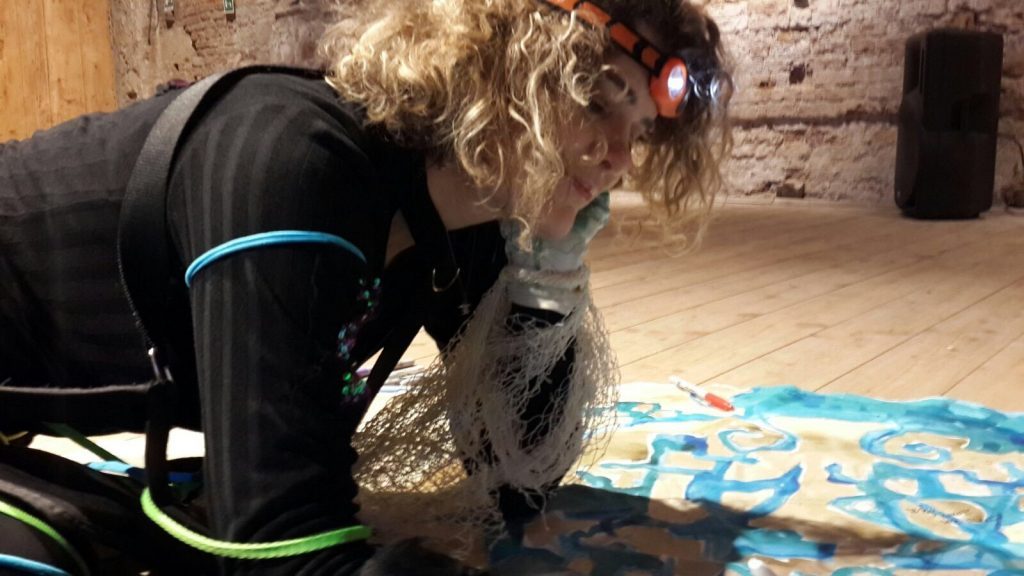
The second artist of our interview series on womanhood and women’s freedom is Aslı Kutluay, one of the Art50.net artists who focus on women’s issues, and who, as a lovely coincidence, also happens to have done an exhibition at Cer Modern especially for March the 8th.
Aslı Kutluay believes in nature, healing and a positive outlook on life. In her paintings, she sometimes takes women out of the spaces they are stuck in and lets them fly, and at other times, she depicts women in love who become spices growing in the city, healing others.
We talked to Aslı Kutluay about her sources of inspiration including music, architecture and literature, and her upcoming project that will bring art and science together this time.
I.Ö.: In one of your exhibitions you were inspired by the songs you love, and in another we saw architectural details and installations… You draw artistic inspiration from several different areas; what are your main sources of inspiration in life and artistic practice alike?
A.K.: I see our coming to the world as an existential story and our creations as a reflection of the values we have in life. We go through constant change. We already change body and dimension every seven years. This is why my sources of influence and my creations are very diverse. As I’m a woman, I’m inspired by other women’s typologies, travelling, the sketches I make during these trips, science, sport, and all branches of art. Purification and developing a position against injustice inflicted on our planet and humanity through overconsumption are my main inspirational drives…
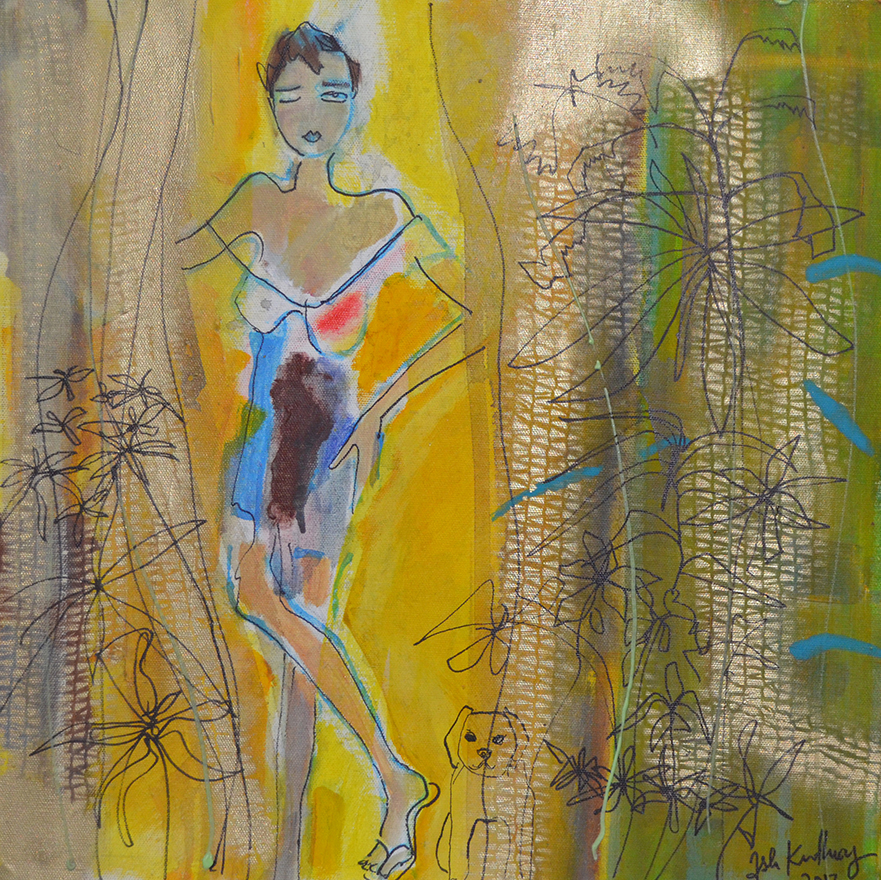
I.Ö.: In the series you have developed for Art50.net, you depict yourself as a woman who had enough with traffic and boring environments, running away and floating in the air. In your “Melting Point” exhibition, you used to say “dreams have set sail”, and “I wish we could fly or blossom now…”. Is it possible for us to argue that the essence of the stories in your exhibitions and artworks are similar? Can we interpret that essence as a quest for tranquillity, return to nature, and relief?
A.K.: Yes, in this capitalist consumerist economy I observe that people are enslaved by the objects that they produce or own. If I have come to this world in such an epoch and in this very dimension, I think this must be by life’s lesson as the subject I care about the most, and I believe I have to draw people’s attention to the issue of purification and relief.
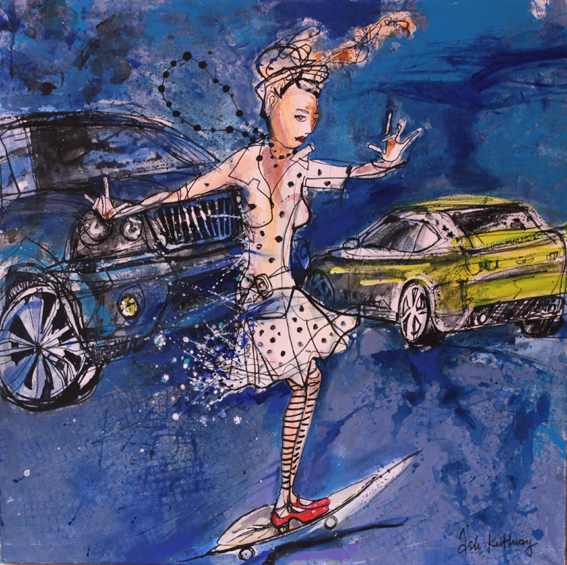
I.Ö.: Then there is the other exhibition of yours titled “88 Spices”, that appears to have a story similar to the one I mentioned in my earlier question… You refer to the event as an exhibition that you have spiced up with pleasant, healing flavors to help us leave sad national and global events behind and where you depict women in love with love itself. There is “A Touch of Spice”, the film by Tassos Boulmetis; it tells the story of a love affair cut short by politics and life’s different stages with different flavors just like spices; but the film doesn’t end as expected… Do the women in your world eventually manage to heal? What’s the place of women in your oeuvre?
A.K.: My entire philosophy of life is based on optimism. The world is a purification, a dimension where the soul reaches maturity. I approach our life experiences as a “sketchbook”. In our sketches there might be certain quests, revelations, confessions, struggles in vain or even mistakes. But when taken as a whole there’s always improvement, justice, absolute healing and maturity. We can’t see it when we’re so close to the events. We have to observe it all from a distance.
I.Ö.: Finally, you announced that this year you would participate to a special event for World Women’s Day. Can you tell us more about it?
I and my mother Assoc. Prof. Ayten Sinman who is a nuclear physicist will be hosted by the Dutch Embassy for Pınar Ayhan’s Documentary Musical. In 1975, my parents worked at FOM Institute of Nuclear Physics in Amsterdam on the project REB or “Relativistic Electron Beam” for a year. Nuclear fusion is a clean and sustainable form of energy without waste product. By 2050 it will replace oil. And my story is actually shaped around that, as I spent a lot of time at futuristic labs as a child thus the design aspect of science and ecological awareness must have drawn my attention… In May I’m planning to develop this project further and to do an exhibition at my own studio, based on my own artistic interpretation, with the documents, electronic and mechanic objects I collected from their lab.

As our current diplomatic relations with the Netherlands are not that great, we artists, thinkers, writers and scientists have a big responsibility in fostering a creative and peaceful dialogue.
You may browse Aslı Kutluay’s works on Art50.net’s gallery here.
March 1st, 2018
Özlem Paker (OZ): We’ve Come Here as Such, We Will Live as Such
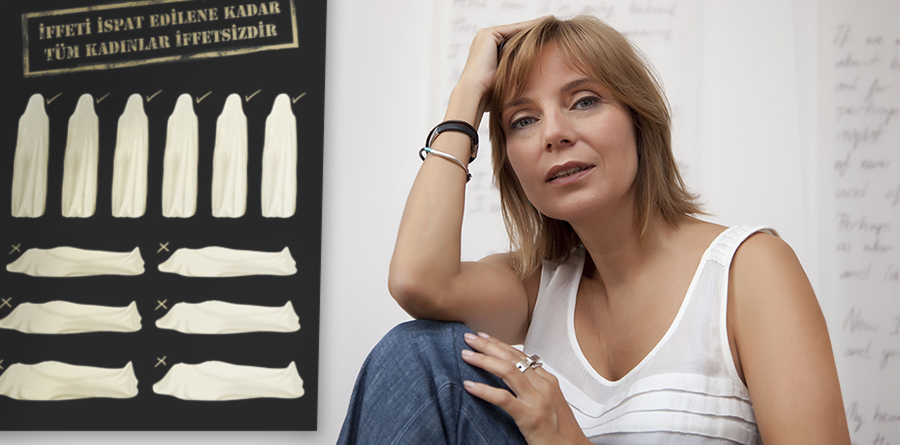
There are some artists from a single work of whom we can understand their message to the world.
When I saw this one work by Özlem Paker Oz as a person deeply interested in issues like womanhood and women’s rights, I immediately understood that I wanted to see more from her, and that I would love what I would see. I thought of it as a form of telepathy specific to women, a special kind of mutual understanding…
Özlem Paker says “the body, the memory and the soul belong to their owner”, “We don’t need your labels”, and “Let us be us”. She explores the female energy, the nature of the female body, fertility and existence; she uses various techniques in her art to express these issues. We had a short conversation with the artist who is based in Los Angeles about the theme of women in her oeuvre and her artistic practice.
I.Ö.: In your exhibition ‘In the State of Ecstacy’ from 2012 you refused to be owned, managed and labelled by others, you resisted being used as a political tool, and you said “We’re here, out in the open, you better go and educate your eyes”. What do you mean by this?
Ö.P.: With her body, mind and structure, woman is a part of nature. By definition, she is different from the dominant male species. And as she’s empath, multidimensional, oversensitive and weak in violence, she has been subject to oppression and exploitation by the dominant species since the end of the matriarchal societies. What is more, in conservative societies like ours, you aren’t respected except for motherhood. At this point, we need serious revolutions to change these old thinking patterns. My method of preference in my works, on the other hand, is not to rebel against somebody or act hysterically but to turn to myself and to reveal our forms of existence in awe. A woman’s body, hair, leg, genitalia, her sway, her dance, her choice of profession, her choice of giving birth, her freedom of expression etc. are completely specific to her nature; I say “We’ve come here as such, and we will live as such”.
I.Ö.: Your figurative works generally focus on womanhood. Looking at the current situation, we actually can say that we have come to this point where we should be able to say much more also considering the conjuncture… Will you continue making works women’s rights?
Ö.P.: Nowadays, women’s problems are not particularly acute. To the contrary, we have come a long way and much more swiftly compared to the past. Women all over the world have a higher level of awareness and take initiative more often to claim their power. The dominant male group realizing this, on the other hand, sees that the future is not as bright (for their own balances of power), so they become increasingly oppressive, or even resort to extreme methods at times. The upset in the balance of power pushes them to react in extreme ways and even to become violent. However, the female species does not work that way; she’s capable of going higher and becoming stronger regardless of how many blows she takes. Because in our essence we have giving birth, upbringing, affection, healing and sharing. I believe we will be successful once we turn all this into power through women’s solidarity. Of course, this is a long-term struggle and requires strategic action. As I already mentioned, there has been a breaking point following the matriarchal societies and in every period after that, women remain on the side of the oppressed masses, with her strongest qualities being referred to as her weaknesses. I’ve been aware of these issues as long as I can remember and gave them serious thought and shaped my life accordingly. My main theme has been this since I entered the art academy. Yes, I continue working on the subject, because being a woman, I find it very natural to express womanhood and I consider it my responsibility.

I.Ö: Who are the most influential female artists and writers to you? Whom should we read or follow to understand your work?
Ö.P.: Virginia Wolf, Maya Angelou, Rosa Luxemburg, Barbara Kruger, Martha Rosler and many more. It’s important to follow the Feminist thinkers, writers and activists, we have a lot to learn from them all.
I.Ö: You’re a multidisciplinary artist experimenting with a variety of techniques including video, photography, architectural installations and collages. Is there a special reason why you avoid commitment to a certain medium? What kind of works do you produce these days?
Ö.P: I grew up with various artistic fields; I became involved and was educated in dance, singing, theatre, performance, visual arts and interior architecture to differing degrees. Multimedia was eventually born and so I was able to combine them all. For me, every new project is a journey into discovering and creating myself from scratch, and with every new journey I feel enhanced. In short, interdisciplinary work enriches the oeuvre. These days I’m working on a few pieces from my most recent Perpetual Voyage series. Here I focus on women’s struggle for survival as well and I emphasize that life is in itself an enormous struggle under any circumstances.

I.Ö.: Especially when I saw your work “Double Hımmm” for the first time, it touched me immediately. I thought that as a woman, I immediately got the message you wanted to give, and that I even made it my own through my own biographic experience. What is your message to your potential female collectors?
Ö.P.: I always say that ‘Art is therapy’. In choosing a particular work, we feel closer to the one that we subconsciously feel will provide us with it. We also want to connect with the artist’s mind and soul, to see the world through his eyes and to feel it through his soul. I noticed that for me, this was easier to achieve through humor; when irony, simplicity and thought-provokingness combine, you reach your audience much more easily and establish a much more sincere communication. My works Hımmm, Aaaah and O-oooh are part of the ‘Bodial Expressions’ series. Minimal but strong works where I combine facial expression with body language, and which I name expressively and where I emphasize we must make peace with our bodies. Double Hımmm, on the other hand, points to the importance of tranquillity in any kind of relationship. And this feeling of tranquillity is very therapeutic for the viewer.
You may browse Özlem Paker’s works on Art50.net’s gallery here.
